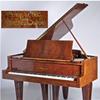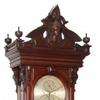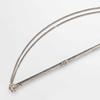The Curator’s Eye Presents Arms and Armour
- NEW YORK, New York
- /
- July 08, 2013
Across time and cultures, there has always been a need to defend oneself. Today, The Curator’s Eye (www.CuratorsEye.com) highlights several of the notable arms and armour available for private sale and currently on display through the online exhibition. The Curator’s Eye presents a global collection of swords, crossbows, helmets, and firearms, among other items. These objects combine history, utility, and beauty of function with a strong representation of their particular culture, as well as offering the enthusiastic private collector a unique opportunity to own a physical connection to the past.
Protection: Armour, Helmets, Masks
A composite German Maximilian field armour, circa 1520, begins the selected offering of arms and armour on The Curator’s Eye. This notable set, of bright steel, bears the Nuremberg beschau, or quality control mark which was controlled by the city. The armour has a close-helmet, Almain collar, and is also decorated throughout with flutes.
An Italian 'Savoyard' Helmet, circa 1620, is of distinctive fashion and was intended for wear by the cuirassier or heavy cavalryman. They are usually referred to as ‘Savoyard’ helmets, because, by tradition, many were taken as booty from the troops of Charles-Emmanuel I of Savoy following their unsuccessful assault on the city of Geneva, Switzerland, on the night of 11 December 1602.
Particularly interested in making a statement while protecting the head, this intriguing Japanese helmet, or kabuto, is in the distinct form of a Portuguese hat from circa 1580-1620. Made of six overlaid plates of russet iron, it has a raised edge, raised rivets, and inlaid silver decoration. The lower section of the plate displays larger areas of decoration applied in silver and gold leaf, with the 'exotic' nature of both the shape and decoration of the helmet enhanced by the possibly mainland Asian style of decoration. The gently curving rim of the helmet has an applied edge and the underside has a metal band for the fittings of the neck-protector (shikoro) traditionally found on Japanese helmets.
Also hailing from the island of Japan is the Samurai mask. The mempo, or menpo, covers half the face and this example is an exceptional iron mask with deep wrinkles on the cheeks and a protruding and split chin and a detachable nose, wide mouth and moustache holes. It includes a black-lacquered four-lame throat guard with red and tan lacing. The samurai were the warrior class in Japan that served to protect the nobility and first appeared in the 9th century. The origins of the Samurai were considered civilians and had to provide their own weapons and were the first organized army in Japan.
One of the earliest examples of armour available on The Curator’s Eye is a an ancient Greek bronze helmet of the Chalcidian type, circa 550-500 B.C. This remarkable artifact has a dent the size of an ancient sling bullet on the right side, possibly marking its battlefield history. It also exhibits large repoussé volutes on the rounded cheek pieces. The Chalcidian type helmet is identified by its open form design, and began to replace the more restrictive Corinthian type helmet on the Greek battlefield in the 5th century BC. By the time of the Peloponnesian War (434-402 BC), the Chalcidian helmet was the most widely used helmet in the Greek ranks. Chalcidian helmets were produced in a number of different workshops in antiquity with the quality running the gamut from crude rudimentary designs to master works of the armor smiths’ craft. This is a very rare early type and is intact, in excellent state of preservation.
Firearms: Cannons, Pistols
As emphatic statement pieces, this pair of English Cannon has come to the market by direct descent in the family of Eyre Coote, son of Sir Eyre Coote, who was born in Jamaica in 1806 where his father was Governor general. The pair of bronze cannon, made circa 1830 by James Wolff, resided in the Irish home of the family until after World War Two. These historic remnants of the British Empire are both 37 inches, with a tapering five stage barrel with loop cascabel and pull hammer mechanism.
A pair of Saxon wheel-lock holster pistols, formerly in the collection of the Saxon Electoral Armouries at Dresden, are inlaid with engraved horn plaques, including a pair of grotesque masks flanking the barrel tangs, and both engraved with The Arms of Saxony and The Archmarshalship of The Holy Roman Empire on the pommel. Dated to 1591, these pistols of the Trabanten-Leib Guarde of the Elector Christian II are fine examples of historic firearms.
In the same vein, though slightly less dangerous, a late 18th Century snuff box in the form of a double-barrelled flintlock pistol is a charming collector’s piece.
Swords: Geman Riding, Indian Zulfikar
A German riding sword from the collection of the Duke of Brunswick presents an opportunity for the private collector to own a circa 1640 piece with important provenance. This slender double-edged blade is finely etched with hatched foliage and inscribed ‘Soli Deo Gloria’ on both sides, and was exhibited in the Tower of London in the 1950s.
In contrast to the restrained Germanic decoration of the riding sword, a rare S-shaped Zulfikar sword from India illustrates an ornate alternative for collectors. Zulfikar swords are relatively rare and this example is unusual for the pronounced curve of its double-edged steel blade. As with other zulfikar swords, this example has a split end. The blade dates to 1709, and the iron or steel hilt is overlaid with silver and silver-gilt in stylised Mughal-inspired poppy designs.
Documents: Churchill, Lincoln, Madison
In addition to the arms and armour, The Curator’s Eye also presents a number of war-related rare books and historic documents. A signed, first English edition of Winston Churchill’s The Second World War is on offer. In 1953, while the last of the six volumes of this work was still being published Churchill was awarded the Nobel Prize in Literature "for his mastery of historical and biographical description.”
An important Abraham Lincoln signed naval commission for Captain Joseph F. Green, dated February 21, 1863, joins the historic war documents available. Commander Green was a senior naval officer during the Civil War blockade of Charleston, South Carolina, and was ultimately appointed Rear Admiral by President Grant in 1870. This commission bears a bold and dark signature from Abraham Lincoln and is also signed by Gideon Welles, Secretary of the Navy.
From an even earlier American conflict, a military commission signed by James Madison rounds out the group. This fine and historic document appointed James W. Bryson as Second Lt. and was signed by Madison on June 1, 1810. During the War of 1812, Bryson served as assistant quarter master under Gen. James Taylor, paymaster of the Northwestern Army based at Newport Barracks, across the river from Cincinnati.
The Curator’s Eye is the distinctive online platform for the finest art and antiques from distinguished dealers around the world. To view more exceptional arms, armour, and historic documents from cultures across the globe, visit www.CuratorsEye.com.
Contact:
Leah TharpeThe Curator’s Eye
Leah.Tharpe@CuratorsEye.com
CuratorsEye@gmail.com
888-599-5099
http://www.curatorseye.com
About The Curator's Eye, LLC
A scholarly online exhibition connecting museums, collectors, and dealers with the finest art and antiques available on the market.
















